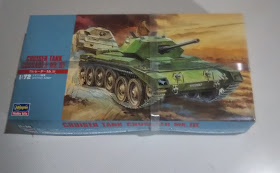It's time to see the Crusader Mk III rise up like a phoenix from the box.
 This is the Crusader Mk III.
This is the Crusader Mk III.
 This is the box.
This is the box.Crusader Mark III: first to bear the six-pounder
Prior to the climactic battle of El Alamein, most
Crusaders had been retired from regular frontline units, replaced by much more
effective M3 Lee/Grant medium tanks. The Crusaders were relegated, with M3
Stuarts, to screening and scouting forces, to exploit breakthroughs, or
relegated to secondary sectors. However, when the need for a new heavy cruiser
tank, expressed since 1940, appeared compromised, a stopgap measure was taken
in March 1941.
I saw on the internet some people saying that the sprues should be washed in soapy water. So I did.
And then I saw articles saying that it wasn't necessary with newer models. Your thoughts please.
Pre-painting.
When I was a newbie, (I am really,) I often excitedly rushed into building a model and then found that I couldn't reach to paint parts of it properly.These days, I always give the majority of the plastic a coat of base coat before I start cutting.
 Prepainted sprues.
Prepainted sprues.Hull build.
Looking at the hull through a romantic blurry lens... but you get the idea.
Turret build.
There were trials to adapt the very effective 6-pdr
(57 mm/2.24 in) AT gun to a tank turret, and finally the Crusader was chosen.
This was the first time this already well-proven gun was mounted on a tank.
This led to a complete redesign of the interior, a new increase in frontal
armor (now 51 mm/2 in), no more auxiliary turret, better protection for the
turret mounting and around the ammunition racks, and some improvements to the
ventilation system.
The crowded turret, equipped with exhaust vents for the gun
fumes also dictated a drastic reduction of crew (now three, the commander was
also the loader).
Painting.
I'll be doing the green version. R.A First armoured division Tunisia 1943.
A coat of green paint.
Notice the brown to suggest mud. Need to get that on before I put the tracks on. Be difficult to get a brush in afterwards.
Shading panel lines and some panels with black.
Painting the tyres black and chipping with grey.
White stripe and another coat for the interior.
Nearly done.
The Mark III was now propelled by the Liberty
Mk.IV, latest evolution of Nuffield V12. The new gun, with 50 rounds (against
110 for the previous 2-pdr), was provided with some AP rounds, and had a far
better punch against existing Axis tanks, notably Panzer III and IV. The Mark
III replaced all existing versions and was largely produced, form early 1942 to
mid-1943. But, by then, the Crusader was seen increasingly as obsolete, being
already replaced by more capable Cavalier, Centaur and Cromwell tanks, the new
long-awaited generation of "cruisers". Despite of this, they played
their part in the second battle battle of El Alamein. Their great speed could
still be exploited in some occasions.
Decals.
Subtle dry brushing with light sand.
Adding a stretched sprue antenna. Need a bit of practice with that. Bit thick and a bit long. You will notice in the final pictures that it is shorter. I think I'll have another go later.




The Mark III was now propelled by the Liberty Mk.IV, latest evolution of Nuffield V12. The new gun, with 50 rounds (against 110 for the previous 2-pdr), was provided with some AP rounds, and had a far better punch against existing Axis tanks, notably Panzer III and IV. The Mark III replaced all existing versions and was largely produced, form early 1942 to mid-1943. But, by then, the Crusader was seen increasingly as obsolete, being already replaced by more capable Cavalier, Centaur and Cromwell tanks, the new long-awaited generation of "cruisers". Despite of this, they played their part in the second battle battle of El Alamein. Their great speed could still be exploited in some occasions. By mid-1944, many were converted on the stocks, or remained in home defense units, and were used for tactical drilling until 1945. The Mark III remains the biggest production of the entire Cruiser VI series.
I'm ready for my close-up Mr DeMille.
It's all done. What do you think folks?



Succession and heritage
The Crusader, and especially the Mark
III, was considered as a stopgap before the arrival of heavier Cruisers, which
were currently in developments and trials.
The mid-1940 specification of the
Directorate of Tanks and Transport targeted three companies: Vauxhall,
producing the Churchill tank,
and both Nuffield and the Birmingham Railway
Carriage and Wagon Company, producing the Crusader. The Nuffield designers
produced, in a rush, an upgraded Crusader, the A24 Cavalier, also
called later Cromwell I.
The Cavalier was quickly approved by the army and developed in such a haste, with existing components, and the Crusader Nuffield Liberty engine, that many problems quickly occurred in the field. But with added armor and equipment, a larger hull, it showed poor performances and of the original order, only 500 were built. The development of a heavy cruiser tank led to the Rolls-Royce Meteor powered Cromwell tank, in 1943,
alongside the Centaur. The Cromwell, in turn, led to the development of the Comet, which itself was influential in the design of the most successful British tank of the cold war, the legendary Centurion main battle tank.
Next up, a Chruchill I think. Look, I got a box.













































Comments
Post a Comment